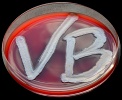| Species/Subspecies: | Mycobacterium marinum | ||||||||
|---|---|---|---|---|---|---|---|---|---|
| Category: | Zoonotic | ||||||||
| Etymology: | Genus name: small fungus-like rod. Species epithet: from the sea. | ||||||||
| Significance: | [Of minor importance] | ||||||||
| Taxonomy: | Class Actinomycetia Order Mycobacteriales Family Mycobacteriaceae Genus Mycobacterium |
||||||||
| Type Strain: | ATCC 927 = CCUG 20998 and 27843 = NCTC 2275. | ||||||||
| Macromorphology (smell): | |||||||||
| Micromorphology: | Acid-alcohol-fast long rods. It has been reported that M. marinum can form endospores. This finding is, however, controversial (see references 105 and 106 below) and has not been verified. | ||||||||
| Gram +/Gram -: | G+ (but difficult to gram stain) | ||||||||
| Metabolism: | Aerobic- | ||||||||
| Catalase/Oxidase: | |||||||||
| Other Enzymes: | Urease +. | ||||||||
| Spec. Char.: | M. marinum is a slow grower (it takes more than 7 days to see colonies with the naked eye).Generation time: 6-11 h. Photochromogenic. Optimal growth temperature: 33°C. | ||||||||
| Special Media: | |||||||||
| Disease: | Intracellular granulomatous disease in fish. Swimming pool granuloma in humans. |
||||||||
| Hosts: | Fish, frogs and other poikilothermic animals. Can cause skin lesions in humans. | ||||||||
| Clinical Picture: | |||||||||
| Genome Sequence: |
|
||||||||
| 16S rRNA Seq.: |
| ||||||||
| Taxonomy/phylogeny:
|
About 175 species have been described within genus Mycobacterium and this genus is closely related to Rhodococcus, Nocardia and Corynebacterium. M. marinum is very closely related to M. ulcerans. | ||||||||
| Comment: | M. marinum can produce a yellow photochromogenic pigment in contrast to M. ulcerans. | ||||||||
| Reference(s): | No. 72, 105, 106 | ||||||||
| Updated: | 2023-03-02 |
